|
We said 2002 series was the
turning point of BMW's history. It found the winning formula for BMW -
compact sports sedan - and set new sales record, with 850,000 units
sold. But BMW did not rest on the laurel. By the time 2002 was cruising
to sunset in the mid-70s, a greater successor was on the pipeline. That
was the 3-Series.
Now we know the
3-Series was the most successful model in BMW's
history. In 30 years and 4 generations, some 9.5 million units were
sold. That accounted for more than half the sales of the company ! It
was so popular because it set new standard in driver appeal and quality
while providing decent practicality. Most crucial, such qualities can
be obtained without costing a fortune. Unquestionably, the 3-Series was
a premium price vehicle, but it cost no more than a big Ford or a big
Citroen. Plenty of people were willing to sacrifice space for the
incomparable driving excitement and premium feel it offered. No other
cars had achieved this before. Even though Mercedes joined the race in
the mid-80s with 190E (later became C-class) and Audi entered A4 in the
mid-90s, the 3-Series remained the benchmark of the class it created.
E21 (1975-82)
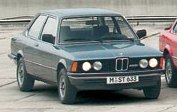 
Compare
with its predecessor 2002, the first generation 3-Series grew longer
and more sporty in appearance. However, it was still a compact sports
sedan with 2 doors only (4-door version didn't arrive until the second
generation). The biggest advance over the 2002 was the all-independent
suspensions with MacPherson struts up front and semi-trailing arm at
the rear. The latter replaced the rigid live axle. Early engines were
derived from its predecessor, such as the 90hp 1.6, 109hp 2.0 and 125hp
2.0 fuel injection engines. They were called 316, 320 and 320i
respectively. Note that a new naming system was used in this car -
started from a single digit series number and followed by two digits
representing engine capacity. Since then BMW named its model families
as 3-series, 5-series, 6-series, 7-series...
The early E21 was
loved for good handling and a modern
dashboard with a driver-oriented center console (this would be a
trademark for BMW's interior in the following 20 years). Because the
car got heavier, performance was actually a bit down on the 2002.
Therefore, 2 years after launch, BMW dropped a pair of straight-6 into
the car - the 122hp 320/6 and 143hp 323i. While 320/6 was criticized
for being too slow, 323i immediately became the icon of BMW. Its
performance and smoothness were beyond the approach of competitors. In
fact, the trend-setting BMW did not have any direct competitors. In its
7 years life, 1.36 million units were sold, easily beating the record
of 2002.
E30 (1982-90)
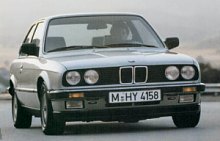 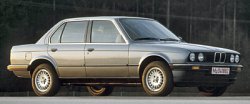
E30
was a refinement of E21. It kept the compact size unchanged and carried
over the suspensions from E21. The major difference was a much
modernized shape and upgraded build quality, both were necessary to
face the challenge of the forthcoming Mercedes 190E. The premium car
image took shape in this generation.
Initially, E30
carried over the engines from E21. Later, the now famous
323i label was replaced by an even more desirable label, 325i. The
larger engine mated with the latest Bosch Motronic engine management
system to produce 171hp. It enabled the 325i to sprint from 0 to 60 mph
in 7.4 seconds and strengthen the performance image of 3-series. On the
other hand, the volume model 318i got a new M40 1.8-litre four-cylinder
engine with 113hp.
In the E30, 4-door
version was added to the 3-Series for the first
time, as were the Touring (estate), Convertible and M3 (we'll talk
about it in a separate article). Now the 3-Series grew to a big family,
no wonder sales increased 63 percent from the first generation.
E36 (1990-98)
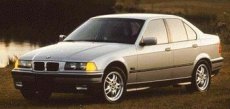 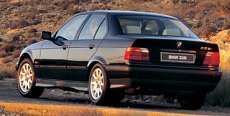
After
the evolutionary E30, the original platform got outdated and needed a
complete renew. Therefore BMW launched the all-new E36 3-series in
1990. This car grew a lot in size - 120 mm longer, 57 mm wider and 130
mm longer in wheelbase. This mean the E36 had even shorter overhangs
and more interior space than its predecessor. The engine located
further back in the chassis, allowing 50:50 weight distribution to the
smaller engine models. The chassis was not only much stiffer but had
all-new Z-axle rear suspensions. This gave it superb ride and handling.
In the engine side,
the 316i received a new 102hp 1.6-litre engine; the
318i continued to use the 113hp M40; 320i and 325i had their straight-6
upgraded to 24 valves, producing 150hp and 192hp respectively. In 1994,
325i was upgraded to 328i. Its 2.8-litre engine got just 1 more
horsepower but considerably more torque and an aluminum block for the
first time. Meanwhile, the 2.5-litre engine was detuned to 170hp and
rebadged as 323i. This broke the traditional naming system according to
engine capacity and confused many people.
Unlike the first two
generations, the E36 was initially available in
4-door form. The 2-door joined 2 years later, and it was called
"3-Series Coupe" because it got a lower roof, more steeply raked
windscreen and other styling tweaks to distinguish from the sedan.
Another new variant
was the 3-Series Compact, a hatchback version
created to cover lower price segment. However, this car was never
popular because it could not match a regular front-drive hatchback for
space efficiency. After trying in the E36 and E46, BMW finally pulled
the plug of the Compact and simply went to develop 1-Series and Mini.
E46 (1998-2005)
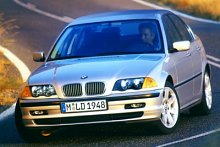 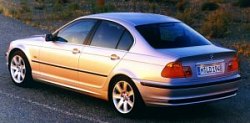
When
BMW developed the fourth generation 3-Series, it had got a lot of
competitors. Cars like Mercedes C-class, Audi A4, Alfa Romeo 156 and
Lexus IS joined the segment. BMW knew it had to upgrade build quality
and refinement to keep its leading position. Therefore the E46
concentrated on refining the basic architecture of E36. It got an
upmarket look, classy interior materials, better sound insulation,
better isolated suspensions (via improved subframe and aluminum
suspension arms), a 70% stiffer chassis and twin-balancer shafts to the
4-cylinder engine. It became so refined that journalists described it
as a mini 5-Series.
The car grew a
little from its predecessor - 26 mm longer, 37 mm wider
and 25 mm longer wheelbase. This brought more space to the cabin again.
On the other hand, wider tracks improved handling a little, although
the heavier body and better isolation led the drivers felt less
exciting subjectively.
Initially, E46 had
its 2.5-litre and 2.8-litre straight-6 upgraded to
Bi-Vanos (i.e. adding VVT to the exhaust side). This brought more low
speed torque but no more maximum output, thus the early E46 was slower
than the car it replaced.
By 2000, the 193hp
328i was upgraded to 231hp 330i as BMW introduced
the new M54 engine. Performance improved a lot. Now 330i became a
performance icon. Meanwhile, 323i had its 2.5-litre engine tuned to
192hp and renamed back to 325i.
Next year, the new
generation Valvetronic four-cylinder engine made its
debut in the 318ti Compact.
After 3.1 million
units built, the E46 was replaced by E90 in early
2005.
E90 (2005-2011)
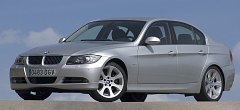 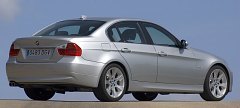
The E90 was designed during
the tenure of Chris Bangle as BMW's design chief. This means it had a
certain degree of oddity in its look. Objectively speaking, it was
probably better than the last E46. The new car grew slightly larger
again in
all dimensions to achieve more cabin room, including 25 mm of
desperately needed rear legroom. Its chassis was 25% stiffer than
before, yet the whole car was slightly lighter. Such were the signs of
progress.
To help reducing
costs, some 40 percent of components were shared with its new brother,
1-Series. These included the new 5-link rear suspensions (replacing
Z-axle), Valvetronic engines and 6-speed transmissions. All engines got
more powerful yet drank less fuel. New N52 3.0-liter straight-six
employed an innovative magnesium crankcase to cut weight. It initially
produced 258 hp, then increased to 272 hp when direct injection entered
the scene in 2007. The same year introduced a new range topper, 335i.
It used a
twin-turbo version of the 3-liter engine good for over 300 horsepower.
0-60 mph was accomplished in merely 5 seconds, strong enough to
threaten the outgoing M3! Moreover, its performance was delivered in a
much more effortless way.
The E90 did not
forget handling either. Its 50:50 weight distribution was achieved by
placing the engine further back than other FR saloons. Its front
suspension and front subframe were constructed in lightweight aluminum.
The battery was placed at the boot. All these measures helped it to
achieve a balance and agility not found in its rivals or any mainstream
4-door sedans, even though fans of the old car might criticized that
BMW had deliberately built more understeer into the chassis to please
ordinary drivers.
Ultimately, it could
not match the sales record set by E46, but that was just because BMW
had introduced 1-Series
and X3 to reduce its reliance on the 3-Series. Now looking back, the
E90's only problem was
just its slightly strange looks.
|